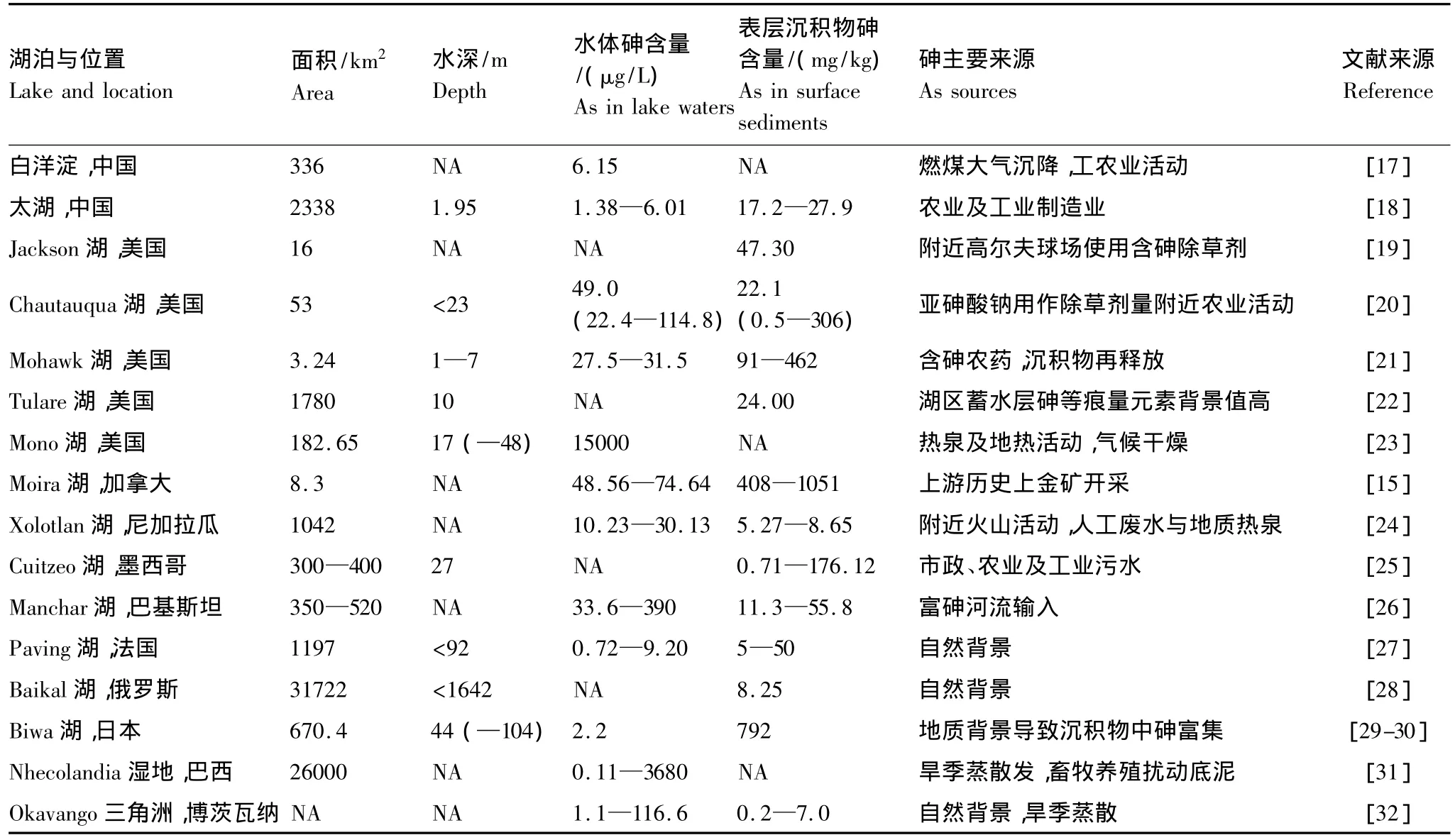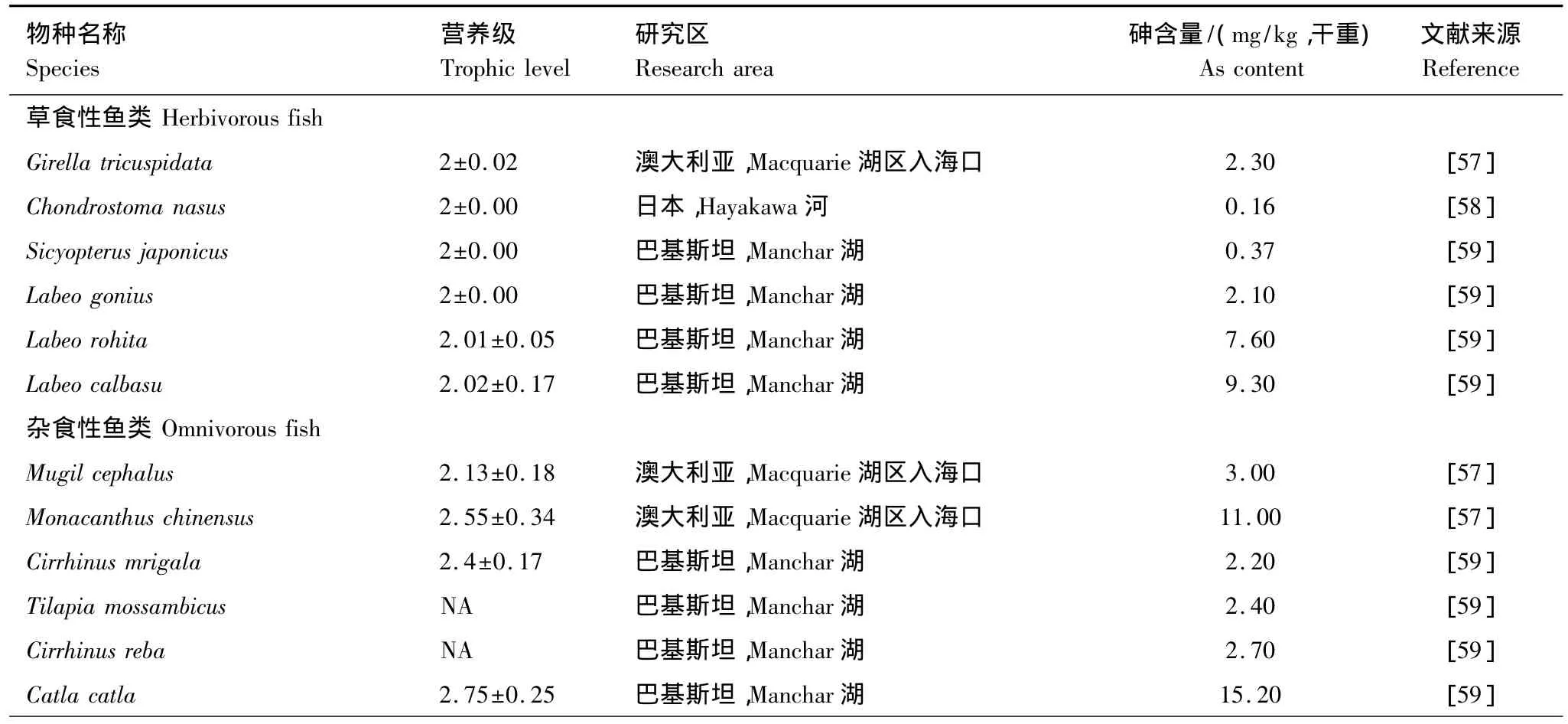淡水湖泊生态系统中砷的赋存与转化行为研究进展
2013-09-11韦朝阳杨林生
张 楠,韦朝阳 ,杨林生
(1.中国科学院地理科学与资源研究所,北京 100101;2.中国科学院大学,北京 100049)
砷(As)是地表环境中普遍存在的微量元素[1],微量As在人们的日常饮食以及空气和土壤中都有发现[2]。因其对动植物的广泛致毒性,As被美国环保局(US environmental protection agency,USEPA)列为清洁水源优先控制污染物[3]。人体摄入As可导致皮肤、肺、肝肾、膀胱等器官的病变,乃至诱发癌症[2]。砷污染业已成为全球关切的重大环境与健康问题之一,对砷污染所导致的环境与健康问题已有大量的研究报道[4-5]。饮水As中毒在多个国家和地区持续发生,包括孟加拉国、印度、中国、阿根廷、智利、匈牙利、墨西哥、罗马尼亚、越南以及美国等都报道过人群急慢性饮水As中毒事件[6]。近年来,海洋与湖泊生态系统中As的研究也受到了越来越多的关注[7]。
相对于大量有关海洋生物As的研究而言,淡水湖泊生物As含量与形态方面的报道尚不多见[8]。早在1900年,德国人Thiergardt等首次分析报道了海洋鱼类中As的含量[9];到目前为止,对各种砷化物在海水环境中的分布及生物体中的含量与形态特征已有比较全面的认识。砷在海藻中以砷糖化合物为主,而在海洋鱼类、甲壳类和软体动物中则主要以砷甜菜碱(Arsenobetaine,AB)形态存在。海洋藻类可从海水中吸收和磷酸盐结构相似的砷酸盐,并在体内完成对砷的甲基化作用,并进而转化为砷糖在体内累积[10];部分有机砷可被海洋生物选择性富集,从而导致海洋生物体内较高的有机砷含量[11]。
虽然淡水湖泊和海洋生态系统都属于水生环境,但湖泊的水理化性质、水体深度、换水时间、水动力学特征、生物区系以及自然和人为污染物质来源均与海洋有很大的不同,这决定了污染物质在湖泊生态系统中具有与海洋明显不同的规律。
目前关于湖泊生态系统As的研究主要包括,As在水生生物、水以及沉积物中的总量和形态分布研究,对于As在生物之间、生物与环境介质之间的迁移与形态转化的研究尚不多见,国内在这方面的研究则更少。尽管多数湖泊As含量处于痕量或微量水平,但As可能会在一些生物体内累积,并通过食物链对人体健康构成威胁。近几十年来,随着我国湖泊流域人口增长与经济的快速发展,工业化、城市化活动排放进入湖泊的各类污染物质剧增,湖泊水环境污染不断加剧,湖泊生态与健康风险日益显现[12]。
结合国内外关于淡水生态系统中As的研究成果及最新进展,本文试总结As在淡水湖泊生态系统各组成部分,包括水体、沉积物、浮游生物、水生植物、底栖动物以及鱼类中的含量水平、富集程度与赋存状态,探讨As在湖泊多介质之间的迁移转化规律,分析影响湖泊生态系统砷形态转化的主要因素,为进一步推动湖泊生态系统As迁移与转化研究以及湖泊流域As污染控制提供借鉴。
1 湖泊水体中的砷
1.1 含量及其形态分布
目前,湖泊水体中发现的砷形态主要有:砷酸盐[AsO(OH)3;As(V)]与亚砷酸盐[As(OH)3;As(Ⅲ)]以及一甲基砷酸[CH3AsO(OH)2;MMAA(V)]和二甲基砷酸[(CH3)2AsO(OH);DMAA(V)][13]。业已明确,MMAA(V)毒性小于As(V),因前者不会干扰浮游植物和更高营养级生物体的氧化磷酸化作用;然而,一甲基亚砷酸[CH3As(OH)2;MMAA(III)]和二甲基亚砷酸[(CH3)2As(OH);DMAA(III)]具有亲脂特性,易与含巯基(-SH)酶结合进而抑制其活性,从而对生物体产生比无机亚砷酸盐更高的毒性。湖泊生态系统中,DMAA(V)为有机砷的主导形态,主要产生于透光层,也存在于深水均温层[14]。
Azcue等报道加拿大湖泊水As含量低于1.0 μg/L[15]。但很多湖泊水体中As浓度很高,约在几十微克每升到几十毫克每升之间(表1)。人类工业与采矿活动,地下富As水体影响,干旱地区强烈的蒸发作用均可导致湖泊水体 As含量的升高[4,16]。

表1 世界各地湖泊水体及沉积物中As的含量水平Table 1 The arsenic levels in lake water and sediments around the world
1.2 影响水体As形态转化的主要因素
1.2.1 氧化还原条件
水体的氧化还原条件影响As的价态、毒性及其水环境化学行为,砷酸盐(As(V))在富氧水体中占主导,而亚砷酸盐(As(Ⅲ))在缺氧水体中占主导[33]。当湖泊存在温跃层时,一般随深度增加,水的氧化还原电位降低,As(Ⅲ)占总砷的比例增加。在温跃层以下,As(V)可相对稳定存在,并容易被铁锰或铝的氢氧化物吸附形成共沉淀;而As(Ⅲ)比较活跃,尤其在沉积物—水界面附近,沉积物孔隙水中呈还原状态的As(Ⅲ)可释放进入上覆水体之中[15]。
1.2.2 水温
浮游藻类可吸收水体中的As(V),并在体内还原为As(Ⅲ),进一步还会通过甲基化作用改变As在体内的存在形态。通常,浮游植物种群结构与数量受季节性变化因素,包括表层水温、光照以及营养条件等控制[27]。夏季湖泊藻类种群达到最盛,湖泊水体中有机砷的含量升高,而冬季则相反。Hasegawa等通过研究日本18个淡水湖泊发现,大部分湖泊水体在夏季有机砷占到总砷的30%—60%,而冬季这一比率则下降到15% —40%[34]。
1.2.3 营养状况
浮游生物吸收As并通过新陈代谢使As的形态发生转化,因而湖泊水体的营养状况与砷形态之间存在明显的相关性。在富营养湖泊水体中,生物活动使得简单的无机砷化物不断转化为复杂的有机砷化物。在富营养湖泊中,As(V)更易于被高密度的浮游植物吸收代谢,并转化为 As(Ⅲ)和有机砷[34]。由于砷酸盐(As(V))与磷酸盐(P(V))化学结构的相似性,浮游植物对As(V)的吸收在贫磷的寡营养湖泊中要高于富磷的富营养湖泊[35],并伴随着更加活跃的将As(V)转化为As(Ⅲ)及有机砷的过程[30]。
1.2.4 生物因素
湖泊中生物因素会极大地影响As(Ⅲ)与As(V)之间的转化,如蓝绿藻类(Phormidium sp.)很容易吸收As(V)并在细胞组织中将其还原为As(Ⅲ),随之As(Ⅲ)又被细胞分泌重新释放到外部介质之中[36];此外,湖泊表层水体中生物降解耗氧可形成局部还原环境,造成有机砷化物被还原,使As(Ⅲ)的含量增加。如日本Biwa湖变温层水体中,As(Ⅲ)所占的比例在春季和秋季会上升,但目前尚不清楚As(Ⅲ)是直接来源于浮游藻类体内As的分泌释放,还是间接地来自其于水体中有机砷的降解作用产物[14]。
陆生植物蜈蚣草(Pteris vittata)可通过根系超量吸收富集As,并在体内将As(V)转化为As(Ⅲ)[37]。而湖泊水生植物则通过物理与化学吸附作用将水体中的As富集到植物体表面,然后通过细胞膜主动或被动地将表面附着的As转运至植物体内,只有很小比例的一部分As由根部直接吸收[38]。将水生植物暴露在As(V)溶液中,植物组织中主要砷形态却为As(Ⅲ),由此说明水生植物能够有效地将As(V)还原成As(Ⅲ),这与陆生植物对砷的转化行为一致[39]。
2 沉积物对砷的吸附释放
沉积物是湖泊生态系统重要的组成部分,对外界水、气、生物质具有容纳与储存能力,湖泊沉积表层还是各种物质和能量转化与交替的场所,表现出特有的环境与生态效应[40]。重金属或类金属(如As)可由人类活动排放进入湖泊,并在底泥中沉积下来。As在湖泊沉积物中的含量通常低于10 mg/kg,不过在世界范围内其变幅很大[1](表1),在未受污染的湖泊沉积物中,As的含量一般在小于100 mg/kg[41];而在某些被污染的湖泊沉积物中,As含量可达 2000 mg/kg[42]。
湖泊沉积物是As等重金属污染物最主要的汇[43]。作为一种潜在的污染源,沉积物中呈束缚状态的As在一定条件下可释放进入间隙水中,再通过风浪扰动、扩散等物理作用迅速进入上覆水体,在短期内可导致湖泊水体As含量的急剧升高[18]。底栖生物生境中As含量水平的增加,可使底栖动物体内富集高含量的As,并通过食物链影响其他动物甚至人类的健康。
As在沉积物中的活性很大程度上受控于pH值和Eh[44]。沉积物中砷的主要形态为无机的As(V)与As(Ⅲ)[6]。当湖泊变温层受到扰动,沉积物—水界面水体Eh升高,,活动性相对较强的As(Ⅲ)可被氧化成活动性相对较弱的As(V)。水体颗粒物中的铁氧化物易与As(V)结合形成共沉淀,同时沉积物中的铁铝氢氧化物、黏土成分、有机质等也会吸附As(V)[45]。而当pH值和Eh较低时,沉积物中As(V)被还原为移动性强的As(Ⅲ),并释放进入间隙水之中[19]。硫也会影响As的溶解性,尤其是在较强还原条件下,硫可以螯合As(Ⅲ)从而增强As的溶解度[46];此外硫还可以通过硫化物矿化沉淀以及硫化铁的吸附作用捕获水体中的 As(V),使其转移至沉积物中[47]。
3 浮游生物对砷的吸收、富集与转化
3.1 浮游植物
在湖泊水体中,浮游植物(Phytoplankton)主要由蓝藻门(Cyanophta)、硅藻门(Bacillariophyta)和绿藻门(Chlorophyta)组成,裸藻门(Euglenophyta)、隐藻门(Cryptophyta)和甲藻门(Pyrrophyta)种类少但也较为常见[48]。
从生态毒理学的角度分析,不同藻类对砷化物的耐受剂量与耐受形态不尽相同。有些藻类对培养介质中As(V)有很高的耐受性,如小球藻(Chlorella vulgaris)对As的累积随着水体中As浓度的增加而升高,最高可达约50000 mg/kg(干重);甚至在As(V)剂量达到10000 mg/L时细胞依然能够存活,但是细胞对于As(Ⅲ)的耐受性(以IC50表示)仅为25 mg/L,在As(Ⅲ)浓度高于40 mg/L时发生藻体细胞及发生溶解[49]。培养介质中磷酸盐可以降低As(V)对敏感藻类的毒性,如当介质中磷酸盐的浓度达到15 mg/L,N∶P比从150∶1降为15∶1时,As(V)对藻类Monoraphidium arcuatum毒性会明显降低;水体介质中磷酸根离子浓度升高后,藻体细胞内的As含量水平也明显下降[35]。可见磷可以有效抑制藻类对As的吸收,从而降低砷化物对浮游植物的毒性作用。
湖泊水体砷还与浮游植物对砷的吸收与代谢活动密切相关。模拟添加As的实验发现,蓝绿藻类(Phormidium sp.)很容易吸收As(V)并在其细胞组织中将其还原为As(Ⅲ),随之As(Ⅲ)又被细胞分泌到外部介质中;藻体内的砷形态多为无机砷,有机砷仅占总砷约1%,藻体中As(Ⅲ)含量随着培养时间的延长持续增加,而As(V)波动性较大,说明藻体细胞可以快速反复地吸收和分泌无机砷化物[36]。
3.2 浮游动物
浮游动物(Zooplankton)捕食方式具多样性,这使得对浮游动物吸收转化As的研究比起浮游植物更具复杂性。在浮游动物中,有的以浮游植物为主要食物来源,属草食性;有的以细菌与碎屑为食,属杂食性;有的则以微浮游动物与原生动物为食,属肉食性[50]。不同食性的浮游动物体内的As赋存形态存在差异性,Shibata等研究日本海浮游生物中砷的形态发现,肉食性浮游动物Themisto sp.和Sagitta sp.细胞中主要的As形态是砷甜菜碱(AB);而草食性浮游动物Calanus sp.中最丰富的As形态为含一个硫酸酯基团的砷-核糖-呋喃糖苷[51]。相对于自然水体影响,浮游动物更容易间接地受其食物来源浮游植物的影响,当水体As浓度升高进而抑制某些优势浮游植物的生长,甚至改变湖泊生态系统浮游植物种群结构时,即可进一步对与其有捕食关系的浮游动物的生存与生殖造成影响[52]。
4 底栖动物中的砷
底栖动物是湖泊生态系统中重要次级生产力,是鱼类等水生动物的天然饵料,例如青鱼、鲤鱼等主要以底栖动物为食。湖泊次级生产力中,超过40%来源于底栖动物的贡献[53],尤其是在寡营养的深水湖泊中,当浮游植物生产力下降时,底栖动物则主导着整个湖泊生态系统的生产力[54]。
湖泊沉积物中As含量水平对底栖动物的自然生境影响巨大,进而极大地影响湖泊生态系统的生产力。底栖动物中的As含量与其栖息的表层沉积物密切相关,如沉积物未受污染的美国旧金山圣华金河三角洲的Corbicula sp.中As含量为5.40—11.50 mg/kg[55],而在英国西南沿海受金属采矿活动污染的Restronguet河中Scrobicularia plana的As含量高达160—190 mg/kg[56](表2)。通常,底栖动物体中的As含量随着沉积物及水体中As含量的增加而增加。不同种类地底栖动物对环境中As浓度的耐受性也有很大差异,当水体中As浓度达到2000 μg/L时,沉积物中寡毛类将会消失[50]。法国科西嘉岛Corsican河因受雄黄矿矿开采的影响,水体及沉积物中的As浓度分别高达3010 μg/L和9450 mg/kg,导致雄黄矿下游的沉积物中水蛭、浮游类及寡毛类底栖物种消失,相反,水生石蝇稚虫及腹足类软体动物却有所增加[51]。由此可见As污染可改变湖泊的生物区系。不同物种对As毒性的敏感度有所不同,当生境中As含量升高时,对As毒性敏感的物种数量会减少以至消失,而耐As毒性的物种数量则会增加。

表2 世界各地鱼类和底栖生物体中砷的含量水平Table 2 The As contents in aquatic biota around the world

续表
5 水生植物中的砷
水生植物一般有3种生活型,即挺水植物、浮水植物和沉水植物[66]。水生植物普遍具有吸收富集As的能力。据Joao Pratas等[67]报道,葡萄牙中部被矿区污染水域中水生植物以沉水植物的As富集系数最高,其中Callitriche brutia对水体As的富集系数高达10000。Brett Robinson等认为尽管水生植物对As吸收转化机制因生活型不同而有所差异,但由体表直接吸收水体中As仍是水生植物吸收As的最主要途径,一般水生植物浸入水体部分的As含量要比接触空气部分的高很多[38]。不过,由于As(V)与磷酸盐()在化学结构上的相似性,As(V)与P(V)在被植物吸收上存在竞争性,当水体浓度很高时,植物对As的吸收会受到抑制[68]。
水生植物中As含量会随着水体中As浓度的增加而升高,而As在根、茎、叶等各部位的分布则与水生植物的生活型密切相关,挺水植物根部As含量要远远高于茎叶中的As含量,浮水植物中根茎叶中As含量基本相当,而沉水植物各部位中以茎的As含量为最高,但在有些湖泊中依然是根部As含量占主导[69-71]。上述结果也基本上印证了Robinson提出的表面吸收为主,根部吸收为辅的假设。
6 鱼体中的砷
6.1 含量及主要砷形态
As在鱼体组织中的含量与水体环境中As的浓度呈显著正相关[20]。鱼鳃、鳃盖及肝脏中含As量最高,而鱼肉中含As量较低[72],As的生物累积优先发生在鱼的代谢器官或组织中[73]。淡水鱼类体内As含量及As形态在不同地区、不同种类之间差异较大[8],总体上As含量水平较低[74],一般在0.1—10 mg/kg(干重,表2)。海洋生物组织中As含量相对较高,且基本上都能够将无机砷转化成有机砷化物,有机砷所占生物体总As的比例也高于陆地生物[9],表明淡水与海洋生物之间存在不同的As代谢能力与机制。
海洋生物体中的As,除在鱼类中常见的无机砷、MMA、DMA、TMAO(三甲基砷氧化物)之外,还有1977年在岩龙虾(Panulirus cygnus)体内首次分离出测得的砷甜菜碱(Arsenobetaine,AB),之后在蛤蜊(Meretrix lusoria)中发现的四甲基砷离子(Tetramethylarsonium ion),以及在小虾中发现的砷胆碱(Arsenocholine,AC)[75],其中AB在各种海洋动物中所占总As比例几乎全都大于90%[7]。与海洋生物相比,淡水动物体内As形态虽大多仍然以有机砷形态为主,但AB的含量比例大为下降,不同物种之间As形态分布也有较大的差异。Silvia Ciardullo等报道意大利Tiber河中的鳗鱼(Anguilla anguilla L.)、平头乌鱼(Mugil cephalus L.)、白鲑(Leuciscus cephalus L.)及鲤鱼(Cyprinus carpio L.)4种淡水鱼肉中As含量最多的仍然是AB,不过As(V)、As(Ⅲ)、MMA、DMA、AC等砷形态也同时存在[76]。Rattanachongkiat等发现Pak Pa-Nang河口沙丁鱼和鲶鱼中AB占总砷的约73%,而DMA与无机砷则分别占到约18%和10%[77]。Slejkovec等研究斯洛文尼亚河流中十几种淡水鱼中砷的形态发现,Drava河中淡水鳕鱼(Lota lota)中DMA占总砷的75%,AB次之,无机砷最少[62]。Rosemond等发现加拿大大奴湖5种淡水鱼类组织中砷形态也有类似的结果,鱼体砷以有机砷形态为主导,包括DMA与AB,但尚有超过50%的为未知有机砷形态,而无机砷形态As(V)与As(Ⅲ)等不超过7.5%[60]。
6.2 鱼体对砷的生物富集作用
水体及沉积物中的As可通过多种途径进入鱼体,As可通过鱼类对水体中悬浮颗粒物与浮游生物的摄食,或通过鱼鳃或鱼体组织中亲脂性细胞膜的对溶解态As的离子交换作用进入鱼体之中[26]。天然水体中,由于水中较低的重金属含量水平及其时空不均一性以及生物有效性等因素的影响,重金属生物富集系数(Bioaccumulation Factors,BAFs)通常被认为能更好地指示生态系统的污染程度及生态与健康风险[78]。
目前大多研究认为,As沿食物链营养级的传递过程中没有生物放大作用(表2)。海洋食物链中处于最低营养级的海藻类As含量最高[79];美国马萨诸塞州的Upper Mystic湖泊食物网中鱼体As含量要比浮游动物As含量低10到20倍[80];室内模拟实验也发现生物体总砷含量沿食物链营养级的提高而显著减少[81]。日本学者Suhendrayatna设计了一个食物链模型,将水蚤(Daphnia magna)、黑壳虾(Neocaridina denticulate)和罗非鱼(Tilapia mossambica)3个营养级的淡水生物暴露于含As(Ⅲ)的水体之中,随着水中As浓度的增加,各生物体中砷含量上升,其中水蚤体中As含量最高,黑壳虾其次,罗非鱼最低。当用含一定剂量As(Ⅲ)的小球藻(Chlorella vulgaris)喂食草食性的水蚤与黑壳虾,再用这些草食性生物体喂食肉食性的罗非鱼时,发现每升高一个营养级,各生物体As含量就下降一个数量级;在这些生物体中,As(Ⅲ)与As(V)为主要形态,甲基砷只占很小一部分[82]。但由于室内模拟生物种类少,不能构成完整的营养级或食物链,另受模拟条件的限制,生物体内的砷可能也未能得到充分的代谢与转化,上述室内模拟实验得到的结果并不一定与真实生态系统的实际情况相符;此外,由于未能充分揭示各营养级生物体中存在的砷形态,某种形态的As是否存在沿食物链或营养级的放大效应,仍有待进一步的验证。
鱼类对As的生物富集作用受到环境水体As浓度、鱼类所处营养级等多种因素共同影响[83]。如加拿大Moira湖沉积物由于受历史上采矿活动的影响,其平均As含量高达637 mg/kg,水体中As含量平均达56 μg/L,其14种分别以底栖生物或浮游生物为食的鱼类体内总As含量为0.03—0.34 mg/kg(鲜重),不同鱼种之间As含量无显著性差,对As的生物富集作用也较弱[84]。美国Upper Mystic湖以浮游生物为食的鱼类体内As含量大于高营养级的肉食性鱼类,As在食物网中无明显的生物富集作用[80]。Mason等发现马里兰州西部河流中草食性无脊椎动物中的As含量高于其捕食者鱼类[85]。此外As在鱼体与环境水体中的形态也有很大差异,如Kaise等研究日本神奈川县Haya-kawa河里的六种鱼类与环境水体砷的形态发现,水体中无机砷占到总砷的93%,而鱼体中则主要为DMA和TMAO[58]。
7 结语
尽管水环境中As已有广泛深入的研究,但关于淡水湖泊As的研究还严重不足,建议从以下方面开展深入的研究:
(1)As在湖泊生态系统中的分布存在明显的区域性,受自然和人类活动的双重影响,有必要从湖泊水体、表层沉积物、浮游生物、底栖动物、鱼类及水生植物等方面系统开展湖泊生态系统As的迁移转化行为及其影响因素研究。其中,水体的物理化学条件,颗粒物组成与性质,沉积物-水界面氧化还原条件及水动力学条件对As的迁移、生物吸收、形态转化的影响是未来开展研究的重点与核心。
(2)我国淡水湖泊均受到了不同程度的污染,As含量水平有逐年增高的趋势。湖泊是区域污染物的汇集地,湖泊生态系统的污染势必导致湖泊生物区系的改变和湖泊生物体中的污染物积累,研究As对湖泊生物区系改变、生物耐性与富集以及As形态转化行为有助于深入揭示区域环境污染(变化)所带来的生态与健康风险,为保护区域环境与人类健康提供科学依据。
[1] Mandal B K,Suzuki K T.Arsenic round the world:a review.Talanta,2002,58(1):201-235.
[2] Ng J C,Wang J,Shraim A.A global health problem caused by arsenic from natural sources.Chemosphere,2003,52(9):1353-1359.
[3] USEPA.Priority Pollutants.2011;Available from:http://water.epa.gov/scitech/methods/cwa/pollutants.cfm.
[4] Smedley P L,Kinniburgh D G.A review of the source,behaviour and distribution of arsenic in natural waters.Applied Geochemistry,2002,17(5):517-568.
[5] Ng J C.Environmental contamination of arsenic and its toxicological impact on humans.Environmental Chemistry,2005,2(3):146-160.
[6] Nikolaidis N P,Dobbs G M,Chen J,Lackovicc J A.Arsenic mobility in contaminated lake sediments.Environmental Pollution,2004,129(3):479-487.
[7] Sharma V K,Sohn M.Aquatic arsenic:toxicity,speciation,transformations,and remediation.Environment International,2009,35(4):743-759.
[8] Schaeffer R,Francesconi K A,Kienzl N,Soeroes C,Fodor P,Váradi L,Raml R,Goessler W,Kuehnelt D.Arsenic speciation in freshwater organisms from the river Danube in Hungary.Talanta,2006,69(4):856-865.
[9] Lunde G.Occurrence and transformation of arsenic in the marine environment.Environmental Health Perspectives,1977,19:47-52.
[10] Clowes L A,Francesconi K A.Uptake and elimination of arsenobetaine by the mussel Mytilus edulis is related to salinity.Comparative Biochemistry and Physiology Part C:Toxicology and Pharmacology,2004,137(1):35-42.
[11] Francesconi K A,Kuehnelt D.Determination of arsenic species:a critical review of methods and applications,2000—2003.Analyst,2004,129(5):373-395.
[12] Wu F C,Meng W,Song Y H,Liu Z T,Jin X C,Zhang B H,Wang Y Y,Wang S R,Jiang X,Liu S Y,Chu Z S,Chen Y Q,Wang C,Hua Z L,Wang P F,Yu Z Q,Fu J M.Research progress in lake water quality criteria in China.Acta Scientiae Circumstantiae,2008,28(12):2385-2393.
[13] Hasegawa H,Matsui M,Sohrin Y.Arsenic speciation including‘hidden’arsenic in natural waters(INTERFACE SCIENCE-Separation Chemistry).Applied Organometallic Chemistry,1999,13(2):113-119.
[14] Sohrin Y,Matsui M,Kawashima M,Hojo M,Hasegawa H.Arsenic biogeochemistry affected by eutrophication in Lake Biwa,Japan.Environmental Science and Technology,1997,31(10):2712-2720.
[15] Azcue J M,Nriagu J O.Impact of abandoned mine tailings on the arsenic concentrations in Moira Lake,Ontario.Journal of Geochemical Exploration,1995,52(1/2):81-89.
[16] Maest A S,Pasilis S P,Miller L G,Nordstrom D K.Redox geochemistry of arsenic and iron in Mono Lake,California,USA.Water-Rock Interaction,1992,1-2:507-511.
[17] Chen C Y,Pickhardt P C,Xu M Q,Folt C L.Mercury and arsenic bioaccumulation and eutrophication in Baiyangdian Lake,China.Water Air and Soil Pollution,2008,190(1/4):115v127.
[18] Wei C Y,Zhang N,Yang L S.The fluctuation of arsenic levels in Lake Taihu.Biological Trace Element Research,2011,143(3):1310v1318.
[19] Whitmore T J,Riedinger-Whitmore M A,Smoak J M,Kolasa K V,Goddard E A,Bindler R.Arsenic contamination of lake sediments in Florida:evidence of herbicide mobility from watershed soils.Journal of Paleolimnology,2008,40(3):869v884.
[20] Foley R E,Spotila J R,Giesy J P,Wall C H.Arsenic concentrations in water and fish from Chautauqua Lake,New York.Environmental Biology of Fishes,1978,3(4):361v367.
[21] Barringer J L,Szabo Z,Wilson T P,Bonin J L,Kratzer T,Cenno K,Romagna T,Alebus M,Hirst B.Distribution and seasonal dynamics of arsenic in a shallow lake in northwestern New Jersey,USA.Environmental Geochemistry and Health,2011,33(1):1v22.
[22] Gao S,Fujii R,Chalmers A,Tanji K K.Evaluation of adsorbed arsenic and potential contribution to shallow groundwater in Tulare Lake bed area,Tulare Basin,California.Soil Science Society of America Journal,2004,68(1):89v95.
[23] Oremland R S,Stolz J F,Hollibaugh J T.The microbial arsenic cycle in Mono Lake,California.Fems Microbiology Ecology,2004,48(1):15v27.
[24] Lacayo M L,Cruz A,Calero S.Total arsenic in water,fish,and sediments from Lake Xolotlán,Managua,Nicaragua.Bulletin of Environmental Contamination and Toxicology,1992,49(3):463v470.
[25] Villalobos-Castañeda B,Alfaro-Cuevas R,Cortés-Martínez R,Martínez-Miranda V,Máquez-Benavides L.Distribution and partitioning of iron,zinc,and arsenic in surface sediments in the Grande River mouth to Cuitzeo Lake,Mexico.Environmental Monitoring and Assessment,2010,166(1/4):331-346.
[26] Arain M B,Kazi T G,Baig J A,Jamalib M K,Afridia H I,Shaha A Q,Jalbanic N,Sarfraz R A.Determination of arsenic levels in lake water,sediment,and foodstuff from selected area of Sindh,Pakistan:estimation of daily dietary intake.Food and Chemical Toxicology,2009,47(1):242-248.
[27] Seyler P,Martin J M.Biogeochemical processes affecting arsenic species distribution in a permanently stratified lake.Environmental Science and Technology,1989,23(10):1258-1263.
[28] Muller B,Granina L,Schaller T,Ulrich A,Wehrli B.P,As,Sb,Mo,and other elements in sedimentary Fe/Mn layers of Lake Baikal.Environmental Science and Technology,2002,36(3):411-420.
[29] Hirata S H,Hayase D,Eguchi A,Itai T,Nomiyama K,Isobe T,Agusa T,Ishikawa T,Kumagai M,Tanabe S.Arsenic and Mn levels in Isaza(Gymnogobius isaza)during the mass mortality event in Lake Biwa,Japan.Environmental Pollution,2011,159(10):2789-2796.
[30] Azizur Rahman M,Hasegawa H.Arsenic in freshwater systems:influence of eutrophication on occurrence,distribution,speciation,and bioaccumulation.Applied Geochemistry,2011,27(1):304-314.
[31] Barbiero L,Furquim S,Vallès V,Furian S,Sakamoto A,Filho A R,Fort M.Natural arsenic in groundwater and alkaline lakes at the upper Paraguay basin,Pantanal,Brazil.Trace Metals and other Contaminants in the Environment,2007,9:101-126.
[32] Huntsman-Mapila P,Mapila T,Letshwenyo M,Wolski P,Hemond C.Characterization of arsenic occurrence in the water and sediments of the Okavango Delta,NW Botswana.Applied Geochemistry,2006,21(8):1376-1391.
[33] Kuwabara J S.Associations between benthic flora and diel changes in dissolved arsenic,phosphorus,and related physicochemical parameters.Journal of the North American Benthological Society,1992,11(2):218-228.
[34] Hasegawa H,Rahman M A,Kitahara K,Itaya Y,Maki T,Ueda K.Seasonal changes of arsenic speciation in lake waters in relation to eutrophication.Science of The Total Environment,2010,408(7):1684-1690.
[35] LeBlanc P J,Jackson A L.Arsenic in marine fish and invertebrates.Marine Pollution Bulletin,1973,4(6):88-90.
[36] Moriarty M M,Koch I,Gordon R A,Reimer K J.Arsenic speciation of terrestrial invertebrates.Environmental Science and Technology,2009,43(13):4818-4823.
[37] Zhang W H,Cai Y,Tu C,Ma L Q.Arsenic speciation and distribution in an arsenic hyperaccumulating plant.The Science of The Total Environment,2002,300(1/3):167-177.
[38] Robinson B,Kim N,Marchetti M,Moni C,Schroeter L,Van Den Dijssel C,Milne G,Clothier B.Arsenic hyperaccumulation by aquatic macrophytes in the Taupo Volcanic Zone,New Zealand.Environmental and Experimental Botany,2006,58(1/3):206-215.
[39] Rahman M A,Hasegawa H.Aquatic arsenic:Phytoremediation using floating macrophytes.Chemosphere,2011,83(5):633-646.
[40] Wan GJ.The Geochemical Principle of Environmental Quality.Beijing:China Environmental Science Press,1988:181-184.
[41] Ackley K L,B'Hymer C,Sutton K L,Caruso J A.Speciation of arsenic in fish tissue using microwave-assisted extraction followed by HPLC-ICPMS.Journal of Analytical Atomic Spectrometry,1999,14(5):845-850.
[42] Toevs G R,Morra M J,Polizzotto M L,Strawn D G,Bostick B C,Fendorf S.Metal(loid)diagenesis in mine-impacted sediments of Lake Coeur d'Alene,Idaho.Environmental Science and Technology,2006,40(8):2537-2543.
[43] Wang S,Cao X,Lin C,Chen X.Arsenic content and fractionation in the surface sediments of the Guangzhou section of the Pearl River in Southern China.Journal of Hazardous Materials,2010,183(1/3):264-270.
[44] Linge K L,Oldham C E.Arsenic remobilization in a shallow lake:the role of sediment resuspension.Journal of Environmental Quality,2002,31(3):822-828.
[45] Gao S,Goldberg S,Herbel M J,Chalmers A T,Fujii R,Tanji K K.Sorption processes affecting arsenic solubility in oxidized surface sediments from Tulare Lake bed,California.Chemical Geology,2006,228(1/3):33-43.
[46] Keimowitz A R,Simpson H J,Stute M,Datta S,Chillruld S N,Ross J,Tsang M.Naturally occurring arsenic:Mobilization at a landfill in Maine and implications for remediation.Applied Geochemistry,2005,20(11):1985-2002.
[47] Couture R M,Gobeil C,Tessier A.Arsenic reactions and mobility along redox gradients in lake sediments.Geochimica Et Cosmochimica Acta,2009,73(13):A248-A248.
[48] Liu X.Phytoplankton Assemblages and Their Response to the Macrophyte Restoration in Typical Urban Lakes of Guangdong,China[D].Guangzhou:Jinan University,2006.
[49] Maeda S,Nakashima S,Takeshita T,Higashi S.Bioaccumulation of arsenic by freshwater algae and the application to the removal of inorganic arsenic from an aqueous phaseⅡ.By Chlorella vulgaris isolated from arsenic-polluted environment.Separation Science and Technology,1985,20(2/3):153-161.
[50] Moore J W,Sutherland D J,Beaubien V A.Algal and invertebrate communities in three subarctic lakes receiving mine wastes.Water Research,1979,13(12):1193-1202.
[51] Mori C,Orsini A,Migon C.Impact of arsenic and antimony contamination on benthic invertebrates in a minor Corsican river.Hydrobiologia,1999,392(1):73-80.
[52] Sanders J G.Direct and indirect effects of arsenic on the survival and fecundity of estuarine zooplankton.Canadian Journal of Fisheries and Aquatic Sciences,1986,43(3):694-699.
[53] Vander Zanden M J,Vadeboncoeur Y.Fishes as integrators of benthic and pelagic food webs in lakes.Ecology,2002,83(8):2152-2161.
[54] Vadeboncoeur Y,Vander Zanden M J,Lodge D M.Putting the lake back together:reintegrating benthic pathways into lake food web models.BioScience,2002,52(1):44-54.
[55] Johns C,Luoma S.Arsenic in benthic bivalves of San Francisco Bay and the Sacramento/San Joaquin river delta.Science of the Total Environment,1990,97(98):673-684.
[56] Langston W J.Arsenic in U.K.estuarine sediments and its availability to benthic organisms.Journal of the Marine Biological Association of the United Kingdom,1980,60(4):869-881.
[57] Barwick M,Maher W.Biotransference and biomagnification of selenium copper,cadmium,zinc,arsenic and lead in a temperate seagrass ecosystem from Lake Macquarie Estuary,NSW,Australia.Marine Environmental Research,2003,56(4):471-502.
[58] Kaise T,Ogura M,Nozaki T,Saitoh K,Sakurai T,Matsubara C,Watanabe C,Hanaoka K.Biomethylation of arsenic in an Arsenic-rich freshwater environment.Applied Organometallic Chemistry,1997,11(4):297-304.
[59] Shah A Q,Kazi T G,Arain M B,Jamali M K,Afridi H I,Jalbani N,Baig J A,Kandhro G A.Accumulation of arsenic in different fresh water fish species-potential contribution to high arsenic intakes.Food Chemistry,2009,112(2):520-524.
[60] de Rosemond S,Xie Q L,Liber K.Arsenic concentration and speciation in five freshwater fish species from Back Bay near Yellowknife,NT,CANADA.Environmental Monitoring and Assessment,2008,147(1/3):199-210.
[61] Arribére M A,Campbell L M,Rizzo A P,Arcagni M,Revenga J,Guevara S R.Trace elements in plankton,benthic organisms,and forage fish of Lake Moreno,Northern Patagonia,Argentina.Water,Air,and Soil Pollution,2010,212(1/4):167-182.
[62] Slejkovec Z,Bajc Z,Doganoc D Z.Arsenic speciation patterns in freshwater fish.Talanta,2004,62(5):931-936.
[63] Ribeiro Guevara S,Bubach D,Vigliano P,Lippolt G,Arribére M.Heavy metal and other trace elements in native mussel Diplodon chilensis from Nothern Patagonia Lakes,Argentina.Biological Trace Element Research,2004,102(1/3):245-263.
[64] Devesa V,Súñer M A,Lai V W M,Granchinho S C R,Martínez J M,Vélez D,Cullen W R,Montoro R.Determination of arsenic species in a freshwater crustacean Procambarus clarkii.Applied Organometallic Chemistry,2002,16(3):123-132.
[65] Casado-Martinez M C,Smith B D,Luoma S N,Rainbow P S.Bioaccumulation of arsenic from water and sediment by a deposit-feeding polychaete(Arenicola marina):A biodynamic modelling approach.Aquatic Toxicology,2010,98(1):34-43.
[66] Lei Z X.Study on Aquatic Macrophyte Vegetations and Their Environment Effects in Lake Taihu[D].Guangzhou:Jinan University,2006.
[67] Kuehnelt D,Irgolic K J,Goessler W.Comparison of three methods for the extraction of arsenic compounds from the NRCC standard reference material DORM-2 and the brown alga Hijiki fuziforme.Applied Organometallic Chemistry,2001,15(6):445-456.
[68] Lee C K,Low K S,Hew N S.Accumulation of arsenic by aquatic plants.The Science of the Total Environment,1991,103(2/3):215-227.
[69] Dushenko W T,Bright D A,Reimer K J.Arsenic bioaccumulation and toxicity in aquatic macrophytes exposed to gold-mine effluent-relationships with environmental partitioning,metal uptake and nutrients.Aquatic Botany,1995,50(2):141-158.
[70] Nateewattana J,Trichaiyaporn S,Saouy M,Nateewattana J,Thavornyutikarn P,Pengchai P,Choonluchanon S.Monitoring of arsenic in aquatic plants,water,and sediment of wastewater treatment ponds at the Mae Moh Lignite power plant,Thailand.Environmental Monitoring and Assessment,2010,165(1/4):585-594.
[71] Mazej Z,Germ M.Trace element accumulation and distribution in four aquatic macrophytes.Chemosphere,2009,74(5):642-647.
[72] Mason R P.An investigation of the influence of water quality on the mercury,methylmercury,arsenic,selenium,and cadmium concentrations in fish of representative Maryland stream:final report 2002.Annapolis,MD(580 Taylor Ave.,Annapolis 21401):Maryland Dept.of Natural Resources,Chesapeake Bay Research and Monitoring Division.2002:69-69.
[73] Culioli J L,Calendini S,Mori C,Orsini A.Arsenic accumulation in a freshwater fish living in a contaminated river of Corsica,France.Ecotoxicology and Environmental Safety,2009,72(5):1440-1445.
[74] Jankong P,Chalhoub C,Kienzl N,Goessler W,Francesconi K A,Visoottiviseth P.Arsenic accumulation and speciation in freshwater fish living in arsenic-contaminated waters.Environmental Chemistry,2007,4(1):11-17.
[75] Cullen W R,Reimer K J.Arsenic speciation in the environment.Chemical Reviews,1989,89(4):713-764.
[76] Ciardullo S,Aureli F,Raggi A,Cubadda V.Arsenic speciation in freshwater fish:Focus on extraction and mass balance.Talanta,2010,81(1/2):213-221.
[77] Rattanachongkiat S,Millward G,Foulkes M.Determination of arsenic species in fish,crustacean and sediment samples from Thailand using high performance liquid chromatography(HPLC)coupled with inductively coupled plasma mass spectrometry(ICP-MS).Journal of Environmental Monitoring,2004,6(4):254-261.
[78] Schaller J,Weiske A,Mkandawire M,Dudel E G.Invertebrates control metals and arsenic sequestration as ecosystem engineers.Chemosphere,2010,79(2):169-173.
[79] Maher W,Butler E.Arsenic in the marine environment.Applied Organometallic Chemistry,1988,2(3):191-214.
[80] Chen C Y,Folt C L.Bioaccumulation and diminution of arsenic and lead in a freshwater food web.Environmental Science and Technology,2000,34(18):3878-3884.
[81] Maeda S,Ohki A,Kusadome K,Kuroiwa T,Yoshifuku I,Naka K.Bioaccumulation of arsenic and its fate in a freshwater food chain.Applied Organometallic Chemistry,1992,6(2):213-219.
[82] Suhendrayatna,Ohki A,Maeda S.Biotransformation of arsenite in freshwater food-chain models.Applied Organometallic Chemistry,2001,15(4):277-284.
[83] Williams L,Schoof R A,Yager J W,Goodrich-Mahoneyc J W.Arsenic bioaccumulation in freshwater fishes.Human and Ecological Risk Assessment:An International Journal,2006,12(5):904-923.
[84] Azcue J M,Dixon D G.Effects of past mining activities on the arsenic concentration in fish from Moira Lake,Ontario.Journal of Great Lakes Research,1994,20(4):717-724.
[85] Mason R P,Laporte J M,Andres S.Factors controlling the bioaccumulation of mercury,methylmercury,arsenic,selenium,and cadmium by freshwater invertebrates and fish.Archives of Environmental Contamination and Toxicology,2000,38(3):283-297.
参考文献:
[12] 吴丰昌,孟伟,宋永会,刘征涛,金相灿,郑丙辉,王业耀,王圣瑞,姜霞,卢少勇,储昭升,陈艳卿,王超,华祖林,王沛芳,于志强,傅家谟.中国湖泊水环境基准的研究进展.环境科学学报,2008,28(12):2385-2393.
[40] 万国江.环境质量的地球化学原理.北京,中国环境科学出版社,1988:181-184.
[45] 刘娴.广东典型城市湖泊浮游植物特征及其对水生植被修复的响应[D].广州:暨南大学,2006.
[66] 雷泽湘.太湖大型水生植被及其环境效应研究[D].广州:暨南大学,2006.
